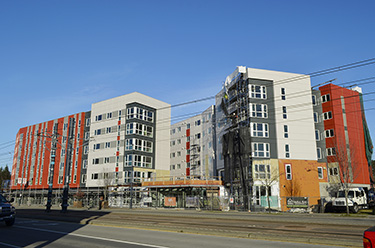|
Subscribe / Renew |
|
|
Contact Us |
|
| ► Subscribe to our Free Weekly Newsletter | |
| home | Welcome, sign in or click here to subscribe. | login |
Environment
| |
 |
March 23, 2017
Sweat the details to make building green pay off
Walsh Construction Co.

Johnson
|
Seattle prides itself as a city leading the way in sustainability. However, if you look at most buildings going up it doesn’t take a keen eye to see that most are built to minimum requirements.
Only a brave few are leading the charge and it’s not hard to understand why. Who wants to pay the premium?
Some have figured it out by using an integrated design approach, supported by a complete project team that understands how building performance, potential and opportunities can work together to address each project’s priorities.
This approach enables the team to understand and target the opportunities with resource conservation measures or design choices to minimize utility costs (energy, water and waste) for the right premium. With a solid incentives package, the team can reap the maximum operational savings.
As a recent example, the project team made key design decisions for a 2.9 percent premium on a $20 million project in Seattle, producing a building that performs 34 percent better than code. Combined savings and incentives produced a simple payback of less than seven years, with an 18 percent rate of return.
We have found that results like these are not one-offs — they are consistent. Whether the focus is on cost, unit affordability or just doing your part to ensure our planet is still comfortable for humankind, they can serve as motivation to anyone seeking to build buildings with optimum performance.
Making the extra effort
First, the project team needs to examine the “baseline,” which represents the minimum requirements — simply, the project built to code — meeting legal, program and funder requirements.
The baseline is developed through benchmarking: examining comparable buildings with similar occupants to determine the expected average annual operational costs. Benchmarking helps to determine the average case.
Each building will have a different use with a distinct set of variables, including tenant use. It’s important to understand the costs related to each of the variables.
Once benchmarked, the baseline factors into the code changes that have been incorporated beyond what is comparable in other buildings. The result is the unique baseline for the project.
The baseline, once established, provides the team an objective and detailed understanding of the building’s performance: Energy Use Intensity (EUI, or miles per gallon for the building), kilowatts, therms, gallons and waste — all converted into cost. Furthermore, the baseline allows us to examine the components of the building from which savings can be obtained, such the building envelope, mechanical, electrical, plumbing, renewable systems and more.
With baseline information, the project team gains insight into which opportunities will most benefit the project’s priorities (cost, sustainability, affordability and so on). Below, a few examples:
• A new construction project: The owner had the requirement to supply air volume twice that of city code. Putting in the extra effort determined that making any improvements to the building envelope beyond code did not make sense, while investing in an energy recovery ventilating system provided great bang for the buck.
• A historic renovation of an unreinforced masonry building: There was a need to replace 100-year-old single-paned windows and improve the building envelope, such as by insulating the walls. These improvements tripled the R-value of the building, which in turn lowered the heating demand to where it made sense to remove the building from the steam system, eliminating considerable maintenance costs.
This turned into a win for the owner (a construction deduct versus a premium), for tenants (lowering utility costs and increasing comfort), and maintenance (old steam radiators replaced with electric cove heaters) — all with a substantially reduced EUI. Great!
• Waste management for new construction: Garbage costs a lot. Recycling costs less. Composting is virtually free. Making it easier for tenants to compost and recycle can save money.
Analyzing the standard practice for an owner in Seattle, we found simply increasing the size of the recycling bin while decreasing the size of the garbage bin resulted in $6,000 of annual savings with no added cost.
• Water savings: This is another low-hanging fruit! How low are you willing to go?
For every gallon supplied, that same gallon is charged in three parts: supply, sewer and drainage. That means every gallon not supplied provides close to three times the savings.
Waterless urinals, low-flow toilets and fixtures — go as low as your threshold allows. The premiums related to water savings are close to zero.
These examples are simple solutions — neither on or beyond leading edge. Operational savings to build better buildings are readily available. But it takes an alternative approach (the extra effort) in pre-construction to get to the best solution.
The bottom line
Build the baseline and understand the opportunities. Allow the project team to target the opportunities and find the best choices at the earliest point in the project.
Pre-construction costs pale in comparison to construction costs. Operational costs far exceed construction costs over time.
What does not change is the average use of resources per person. Tenants will heat their space to what makes them comfortable. They will use sinks, toilets, dryers and more the same number of times. But if it takes less therms, kilowatts and gallons, those savings are yours.
What does change are utility rates. They go up and they go up a lot. Seattle Public Utilities water, sewer and waste rates have increased 11 percent since 2014. Seattle City Light power rates have increased less, but went up 5.6 percent last year.
Bottom line: The extra effort pays and the results are consistent and should speak to anyone.
Making better choices at the earliest point in the project is important. Understanding the premiums, costs, savings and incentives related to those choices early puts you in a position to make the optimum choices for the project. Powerful!
There are several methods and approaches to accomplish this. At Walsh Construction Co., we have developed a unique Seattle-born method, the Asset Management Preservation initiative, which we apply to our cost analysis of new construction and building upgrades.
Again, whether you believe only in the bottom line, building affordable homes or simply making the planet more hospitable, the extra effort is worth it.
Derek Johnson is a project manager who joined Walsh Construction Co. in 2007 after an extensive career in the U.S. Army. He is a key contributor to Walsh’s green building practices, and holds certifications in LEED and Passivhaus.
Other Stories:
- 2 state bills would reward owners who green up their buildings
- How 'negawatts' help the building industry fight climate change
- Next frontier for sustainability? The people inside all those green buildings
- 4 strategies to make office workers healthier and more productive
- ‘Biophilic’ design bonds children with nature
- Eco-friendly transfer station adds playground to be a good neighbor
- Georgia Tech wants a Living Building, but can designers beat the heat?
- 12 Bel-Red townhouses help restore a trashed site



